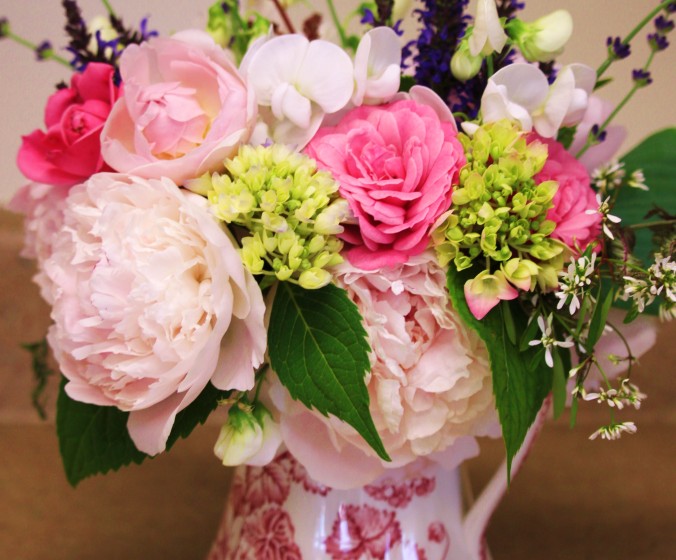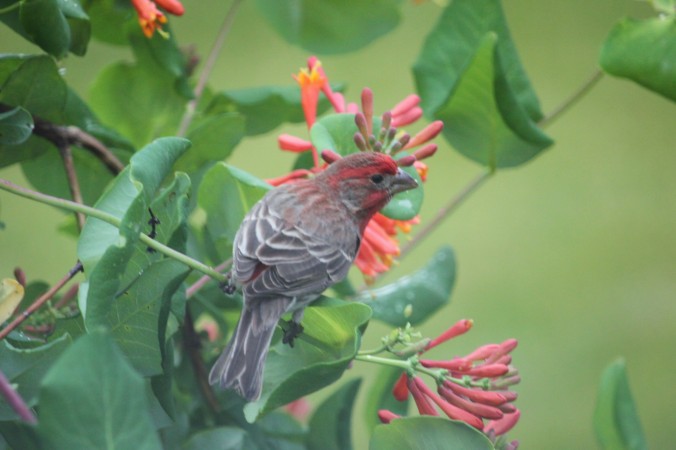Sharon Jessup Joyce
People used to have flower rooms on big country estates. The flower room was easily accessed by a side door, and would have one or two deep-aproned sinks, a countertop — which might be an old wooden table or built-in counters — and shelves of vases, shears, ribbons and other accoutrements for arranging flowers. One of the ladies of the household would be responsible for picking and arranging bouquets for strategic locations in the house, including the entrance hall, the sitting room and of course the dining room. Arranging the flowers was often the job of an unmarried daughter, and depending upon her inclinations and the size of the estate’s outdoor staff, she might pick the flowers herself, or a staff member might pick them and leave them in buckets of water in the flower room for the lady to arrange. Given my humble ancestry, I would actually have been peeling the potatoes in the kitchen, not arranging the posies in the flower room, but I still take pleasure in the fantasy whenever I create bouquets from my own garden.
I’ve always loved old-fashioned bouquets of flowers. You can’t achieve them with the sort of evergreen foundation plantings that have become 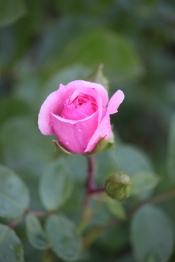 commonplace in urban properties. Instead, you need an old-fashioned cutting garden, which is simply a garden filled with plants that will provide blooms suitable to cut and arrange into bouquets. The best cutting garden plants have multiple blooms (think peony or hydrangea), that will provide enough flowers for several bouquets and still look pretty in the garden. If you plant single-bloom plants (such as daisies or irises) you will need to allocate space for lots of blooms. Some plants bloom more than once in a longer season, such as perennial sweet pea, while others, like many roses, often bloom over an extended period of time. This variety in blooming time and number of blooms is an important consideration in growing a cutting garden.
commonplace in urban properties. Instead, you need an old-fashioned cutting garden, which is simply a garden filled with plants that will provide blooms suitable to cut and arrange into bouquets. The best cutting garden plants have multiple blooms (think peony or hydrangea), that will provide enough flowers for several bouquets and still look pretty in the garden. If you plant single-bloom plants (such as daisies or irises) you will need to allocate space for lots of blooms. Some plants bloom more than once in a longer season, such as perennial sweet pea, while others, like many roses, often bloom over an extended period of time. This variety in blooming time and number of blooms is an important consideration in growing a cutting garden.
If this is starting to sound like you need a big garden, relax. You don’t need a country estate to make a cutting garden that will provide generous — and varied — bouquets from spring to fall. You can create a cutting garden in a small urban or suburban garden, or even on an apartment balcony. In addition to growing flowers that bloom copiously or over an extended period, make sure you grow plants whose flowers have stems that are long enough and slender enough to allow them to be arranged in a vase or jug. You also want some plants that will serve as greens in a bouquet, since greens help to frame and support the flowers.
In our Kingston suburban garden, which we began planting 10 years ago when we moved into this house, there is currently dark pink bleeding heart, white lily-of-the-valley, white and pink perennial sweet pea vines, a pale pink peony bush, two rose bushes (one a shell-pink David Austen and one a dark pink tea rose), several clumps of three varieties of lavender (two dark purple and one mauve), and four mophead hydrangeas, which bloom in shades of cream, pink and mauve. These blooms give us bouquets through the spring and summer. For the fall, we still have lavender, a second blooming of sweet peas, usually more hydrangea blooms, and the rosy late blooms of Autumn Joy stonecrop. We have garden beds in the front of the house, along the driveway, along the shady sides of the house, and in the backyard. Our lowest-maintenance garden beds are built up with extra soil, enclosed with rocks or low rock walls, and top-dressed with mulch. They are also the healthiest and prettiest beds.
My cutting garden has mostly pink, purple and white, because those are the flower colours I prefer. I always plant a few annuals 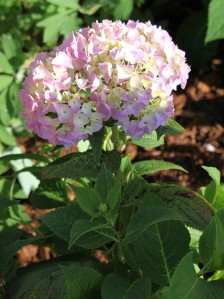 in our front garden bed, to fill in the gaps around the perennials, so some years we also have shades of soft yellow. I don’t care for red or orange flowers, so I don’t plant any, though I sometimes regret that decision a little in the fall. If I was better organized and less squeamish about putting aluminum sulfate into the soil, we could have deep blue hydrangeas, which you can achieve with regular application of aluminum to the root area, but I always chicken out or forget to do it. Anyway, it’s fun to see how the colour of the hydrangea blossoms varies even on the same bush.
in our front garden bed, to fill in the gaps around the perennials, so some years we also have shades of soft yellow. I don’t care for red or orange flowers, so I don’t plant any, though I sometimes regret that decision a little in the fall. If I was better organized and less squeamish about putting aluminum sulfate into the soil, we could have deep blue hydrangeas, which you can achieve with regular application of aluminum to the root area, but I always chicken out or forget to do it. Anyway, it’s fun to see how the colour of the hydrangea blossoms varies even on the same bush.
 You also need greens in a cutting garden. We have four varieties of hosta and two types of fern growing along the shady side of our house. Hosta comes in a variety of shades of green, from a blue-gray to a brilliant lime green, to striped, and it’s fun to combine the right shade of hosta to complement the flowers in a bouquet. I love the gray-green hosta leaves against our palest pink flowers, while the lime green hosta leaves look gorgeous with dark purple lavender or brownish-pink stonecrop.
You also need greens in a cutting garden. We have four varieties of hosta and two types of fern growing along the shady side of our house. Hosta comes in a variety of shades of green, from a blue-gray to a brilliant lime green, to striped, and it’s fun to combine the right shade of hosta to complement the flowers in a bouquet. I love the gray-green hosta leaves against our palest pink flowers, while the lime green hosta leaves look gorgeous with dark purple lavender or brownish-pink stonecrop.
The best way to grow a cutting garden is to first research what plants will grow well in your garden. This is based on your climate, including temperature highs and lows, severity of winter, and average rainfall. Check growing zone information for your area online or through gardening guides. With a fairly modest investment of time and money, you can alter your soil’s composition. You can also commit to watering your garden regularly, but there’s not a lot you can do about average temperatures, severity of winter, or sun 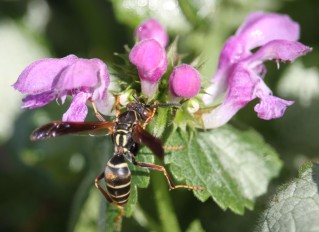 and shade patterns. And unless you are willing to invest in daily work in your garden, you are better off planting things that will thrive under the natural conditions you have. But there’s no point whitewashing this: a cutting garden will demand some work in terms of weeding and watering (when Mother Nature does not oblige). After all, the reason why those evergreen foundation plantings are so popular is that they are low-maintenance. Flowering plants demand a little to a lot more care. Be aware, too, that many plants that produce beautiful blooms also attract butterflies, bees, wasps and hornets. If you have an allergy, as I do, you will need to work with a little more caution alongside these garden visitors.
and shade patterns. And unless you are willing to invest in daily work in your garden, you are better off planting things that will thrive under the natural conditions you have. But there’s no point whitewashing this: a cutting garden will demand some work in terms of weeding and watering (when Mother Nature does not oblige). After all, the reason why those evergreen foundation plantings are so popular is that they are low-maintenance. Flowering plants demand a little to a lot more care. Be aware, too, that many plants that produce beautiful blooms also attract butterflies, bees, wasps and hornets. If you have an allergy, as I do, you will need to work with a little more caution alongside these garden visitors.
We’ve been lucky when it comes to pests such as slugs and aphids, though I did lose all my lilies to beetles. In general, though, I’ve had a successful organic flower and herb garden in two different locations for a total of more than 30 years. It seems that careful plant selection and plant location are key – along with luck, I’m sure.
Above all, pick plants you love. That sounds obvious, but there are fashions and fads in garden plants just as there are in everything else. If 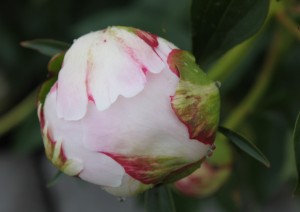 you like a plant — and for perennials, you want to like the foliage as well as the flowers — and do your due diligence to determine that it will thrive in your garden (or on your balcony), don’t be talked out of it in favour of a plant that is on sale at the garden centre, easier to source or being given away by your kindly neighbour. For example, I don’t like begonias, so I never buy any, even if they are just one plant in a planter basket that has lots of other plants I love.
you like a plant — and for perennials, you want to like the foliage as well as the flowers — and do your due diligence to determine that it will thrive in your garden (or on your balcony), don’t be talked out of it in favour of a plant that is on sale at the garden centre, easier to source or being given away by your kindly neighbour. For example, I don’t like begonias, so I never buy any, even if they are just one plant in a planter basket that has lots of other plants I love.
In my next post, I’ll talk about arranging the flowers from a cutting garden into beautiful bouquets. But for now, I’ll end with the reminder that we want a garden we’ll enjoy, not just for the bouquets it will allow us to create, but also where it grows outdoors. Pictured below is a honeysuckle vine that blooms along a pergola in our backyard. It is not a suitable plant for a cutting garden, but the birds and butterflies enjoy it all season, as this little finch can attest.
